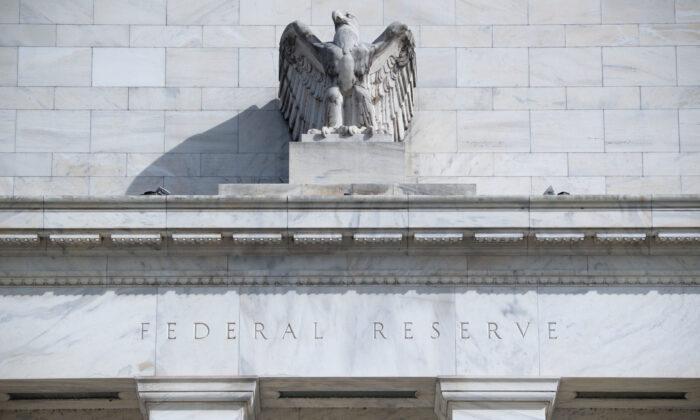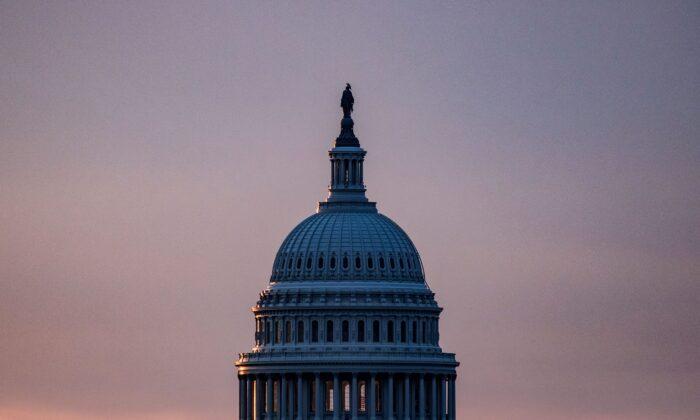Since mid-2022, most money supply measures have been contracting. Despite this, total spending continues to advance at a relatively strong pace. The apparent disconnect between money and spending raises a crucial question: does money still matter?
In their book, “A Monetary History of the United States, 1867–1960,” Milton Friedman and Anna Schwartz provide extensive evidence of how monetary policies had destabilized the economy. The authors urged the Federal Reserve to pursue a more cautious stable policies to promote stability.
M2 Money and the Economy
The following chart updates the relationship between M2 (currency plus most bank deposits) and current dollar spending (i.e., GDP). It shows two-year changes in each variable to depict broad trends. From the 1960s through the 1980s, the relationship between M2 and the economy remained close. Beginning in the 1990s, the relationship is no longer clearly apparent.The most significant failure of M2 was in the lead-up to the financial crisis of 2008–09. At that time, a rapid increase in M2 misled policymakers into believing the money supply was increasing. In actuality, the Fed was busy aggressively selling securities and draining money from the economy. The resulting sharp reduction in money created the worst liquidity crisis since the 1930s and ushered in the financial crisis.
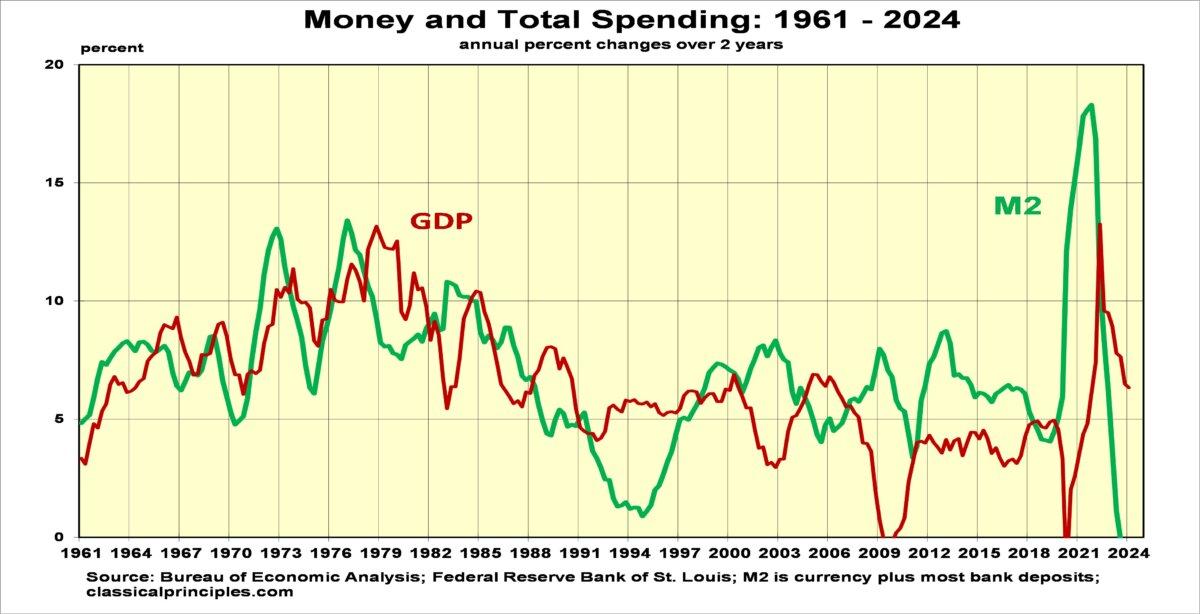
A misalignment between M2 and the economy continued during the ensuing post–2009 recovery. By 2020, the Fed understandably rejected M2 as a reliable guide to policy. However, after failing to track the economy from 1990 to 2020, an explosive growth in M2 beginning in late 2020 correctly anticipated the following surge in spending and inflation.
The concept of money has never been clearly defined. There is no ideal measure of money for all times and all places. All attempts to quantify and define money are only useful to the extent they relate to what happens in the economy.
High-Powered Money: An Alternative Money Measure
High-powered money consists of currency in circulation, securities held by the Federal Reserve, and bank reserves (commercial bank deposits held at the Federal Reserve). High-powered money represents the primary source for the nation’s money supply. It is the amount of money directly controlled by the monetary authorities. Changes in high-powered money represent the first step in the process of increasing or decreasing the money supply however defined.The following chart shows the relationship between high-powered money and the economy from the early 1960s. As with M2, the relationship is fairly close until the early 1990s. Also as with M2, the relationship between high-powered money and spending is much looser after the 1990s. While the spread between high-powered money and the economy much greater, changes in high-powered money have a much better record of anticipating major changes in the economy than M2, or any alternative money measure.
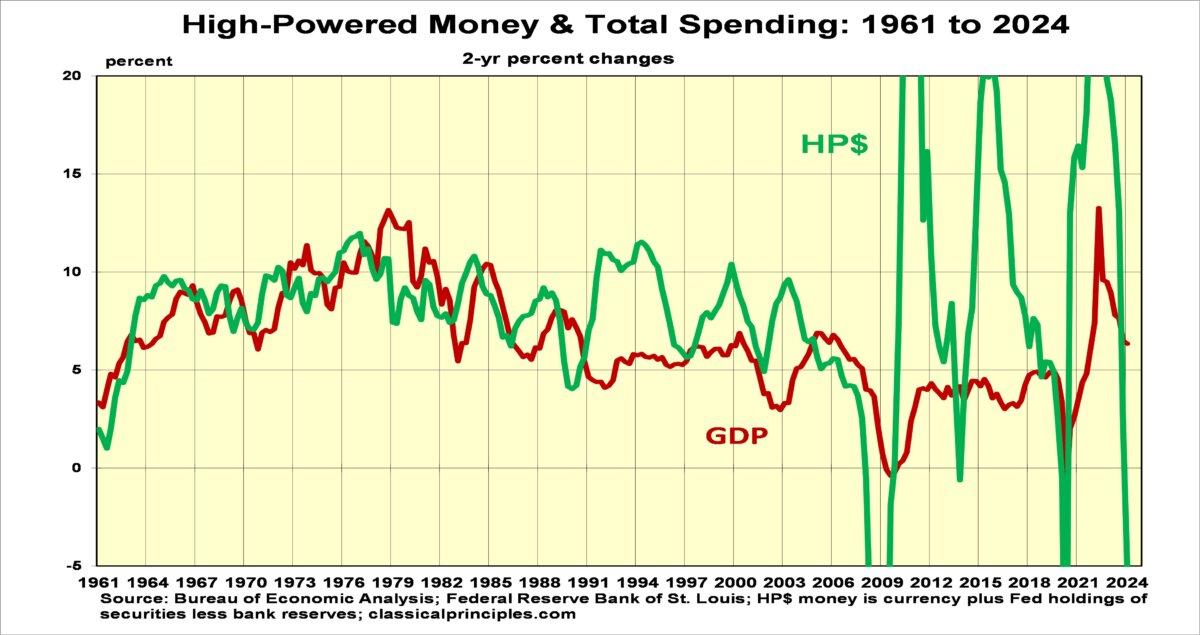
The above chart also provides a potential explanation for why changes in the economy have become progressively less responsive to changes in money since 1990. The close relationship between money and spending prior to 1990 occurred when the Fed’s purchases and sales of securities were more cautious and more stable. After 1990, these purchases and sales became progressively more erratic. The more erratic Fed policy, the less responsive the economy to changes in money.
The volatility of the Fed’s purchases and sales of securities reached new highs beginning in 2008, and again after 2020. These changes were so great it is difficult to visualize the magnitude with percent changes. The use of logarithmic numbers in the chart below provides a clearer picture of the relationship between changes in the Fed’s securities portfolio, high-powered money and the economy. It shows how the Fed’s control of high-powered money remained closely related to GDP in each of the two most recent recessions and recoveries.
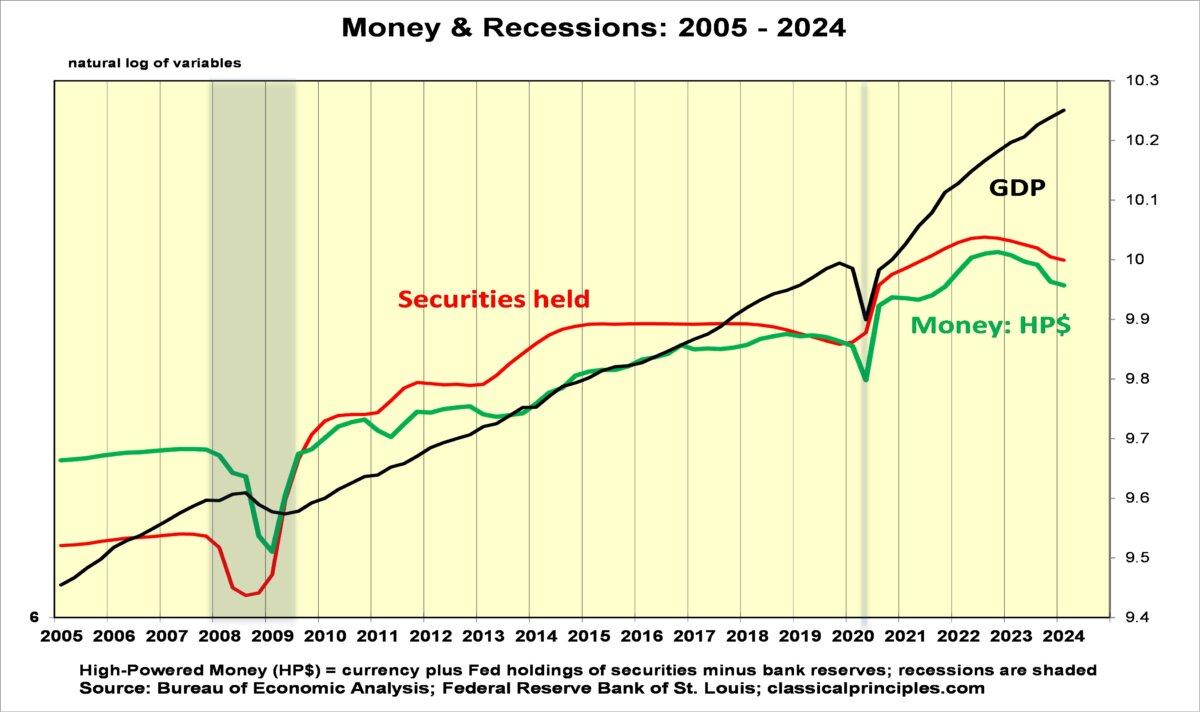
High-Powered Money: Implications for the Economy and Fed Policy
The progressively more erratic Fed policy appears to have impacted the transmission mechanism between money and the economy. As the Fed’s purchases and sales of securities have become more erratic, the economy has become less sensitive to changes in money. The greater stability of the economy, along with an excess of money from 2020, may account for a longer lag between the Fed’s recent tight money and the economy.Given the changing relationship between money and the economy, there is no way to know when the Fed’s guess about its target interest rate is appropriate. When the Fed’s target rate is higher or lower than the market rate, bad things happen. In 2008, for example, the Fed’s target rate was too high, so the Fed sold securities creating a financial crisis. In 2020 to 2022, the Fed’s guess about its target rate was too low. This led the Fed purchase securities, fueling the highest inflation in 40 years.
In light of these policy failures, Fed officials should be less confident about their ability set appropriate interest rate targets. A change in the Fed’s operating procedures would help avoid their current inconsistent and incoherent policies.
For example, currently Fed officials claim their federal funds target is consistent with providing the appropriate amount of money in the economy. At the same time, they claim selling securities and putting upward pressure on interest rates is necessary because there is too much money in the system.
The logical solution: A more coherent policy would be for the Fed to allow financial markets to determine short-term interest rates. To do so, the Fed should stop selling securities and allow financial markets to set the appropriate interest rate. If the market’s rate were to move above the Fed’s current target, it would indicate the Fed’s current target was too low, in which case its current policy of selling securities might make sense. Alternatively, if the market rate were to fall below the Fed’s current target, it would indicate the Fed’s target is too high. In that case, continuing to sell securities would be highly destructive.
Fed officials should stop pretending they possess divine insight into the appropriate market interest rates. As with prices in the rest of the economy, interest rates should respond to supply and demand as opposed to the dictates of government officials. The Fed can best promote a more stable monetary policy by limiting their purchases and sales of securities and letting credit markets allocate resources to their most efficient uses.





